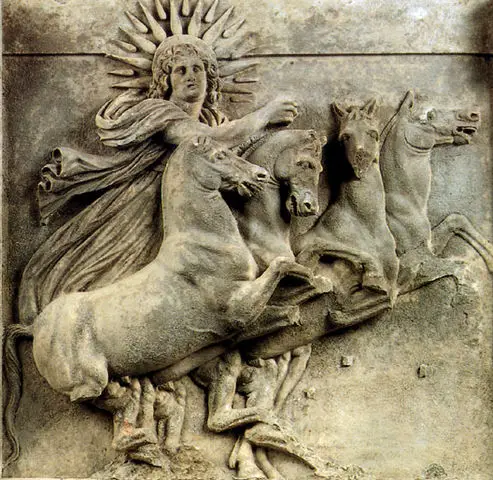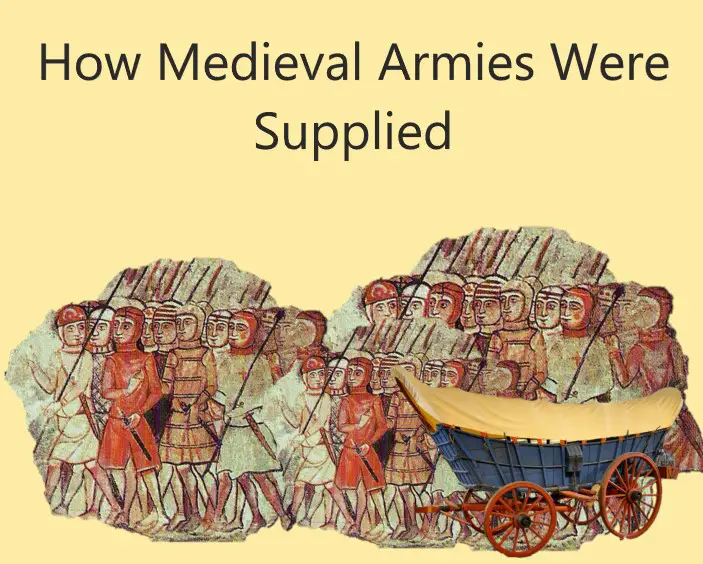
One of the largest problems with medieval warfare revolved around the logistics of supplying and equipping the medieval army. The biggest part of this problem was just how to get supplies to the soldiers fighting in medieval battles. As such here is everything that we as historians know about how medieval armies were supplied.
Generally speaking, most medieval armies would pillage the land around where they were fighting or staying. The more disciplined armies of the later medieval era (1,100-1,500) would send envoys to large cities or towns around their camp to barter for basic goods. The largest medieval armies such as England or France’s military during the 100 Years’ War would build out supply wagons to handle the logistics of fighting wars however this was rare.
Here at The History Ace, I strive to publish the best history articles on the internet. If in the end, you enjoyed this article then consider subscribing to the free newsletter and sharing around the web.
Without further ado, here is all the information we have surrounding just how medieval armies were supplied
Most Medieval Armies Were Supplied by Pillaging the Local Area From the Early to Middle Medieval Period
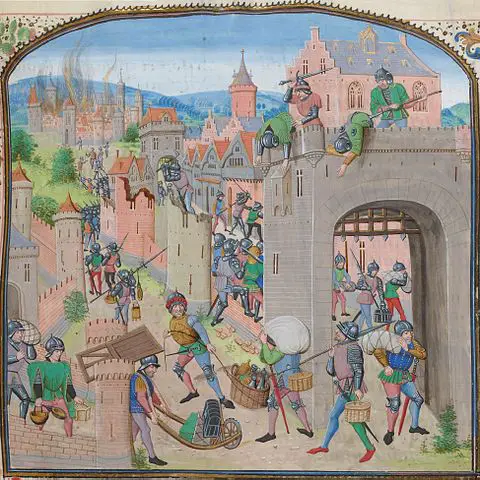
When it came to supplying a medieval army most commanders would simply let their soldiers ransack the local area they were in. Fortunately, armies today no longer do this but if you lived in medieval Europe and an army came through chances are soldiers would simply take your food or possessions.
In fact, it was only up until the late 15th century that the act of pillaging a nearby settlement or town for food by an army started to decline. It was almost expected that an army in medieval Europe would get its supplies by taking them from the local area.
The reason why this was so widespread was because the concept of a unified country/nation did not exist during the medieval era. You would not have identified as being from the kingdom of France; instead, you were from the local village or town. If you were traveling in an army taking from the locals was to be expected because they were just as foreign to you as the enemy was.
This was why one of the most dangerous places to live in medieval Europe was in a prosperous city. Not only did you have to worry about theft from your neighbors but also you had to worry about a wandering army sacking your home and taking your food to supply the army. (If you are interested I wrote up an entire article on why medieval cities were so dangerous. You can read it by clicking here.)
However, this act of pillaging to supply the local army began to change after the 100 Year’s War. This was because this war between England and France which started in 1337 and lasted until 1453 was so destructive for both sides that formal processes had to be put into place to prevent armies from ransacking and pillaging all tows they came across.
Simply put, from the fall of Rome in the 5th century up until the late 14th century medieval armies would supply themselves primarily by pillaging and ransacking the local area. However, as armies became more disciplined and formal this practice would eventually start to go away starting in the 15th century.
How Late Medieval Armies Supplied Themselves: Buying Goods, Supply Lines, and Camp Followers
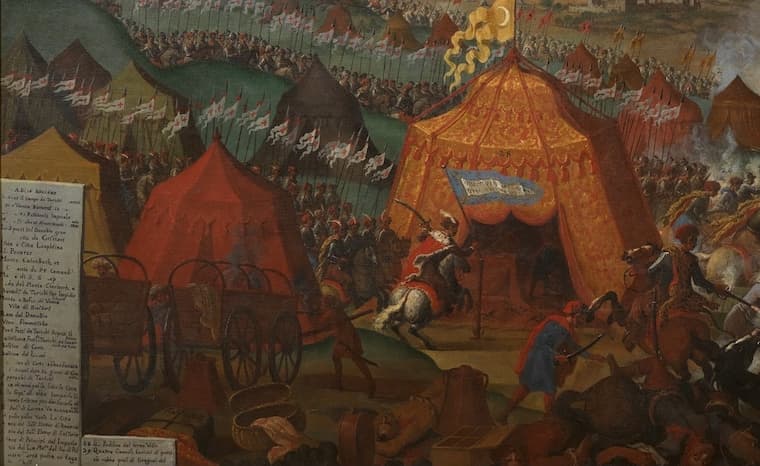
The second way in which medieval armies were supplied was by either buying provisions directly from a local town or from camp followers selling provisions to the army.
This type of supply only happened later on in the medieval period once professional standing armies started to develop. This time period can be seen as starting in the late 11th century with the crusades and going up until the 17th century.
This was the professional way of supplying an army and it required a firm sense of discipline among the medieval troops and a structure put in place to allow for the logistics of supplying a mobile force. This level of professionalism in medieval armies didn’t end up coming around until the mid-13th century in Europe and the 11th century in the Levant with the Crusade.
The reason for this change is due to the massive explosion in medieval army size during this time. It was not uncommon after the 100 Years’ War to see armies of tens of thousands of medieval soldiers fighting across Europe. Because of this growing army size, the demand for a stable and scalable logistics supply line grew as well.
As such the first way that these large medieval armies were supplied was through a baggage supply line of carriages. Medival carriages were simple wagons with two wheels that were hitched up to an ox or horse and used to cart large stores of grain and other provisions to the medieval army.
However, the downside of this medieval baggage supply line of wagons was that it only worked while in friendly territory where you could easily defend it. Once the large medieval army started to get into hostile territory it became too costly to both protect the baggage supply line and the army at the same time.
As such medieval commanders would turn to the other two types of ways to supply their army. The first was to simply send an envoy to a nearby city or town to offer to buy goods from them. At this point in time, large cities were free to conduct trade and would often sell to both armies in the field.
The second way that these medieval armies were supplied in the late medieval period was through camp followers. Often these camp followers would travel behind the army and comprise of the families of the soldiers, cooks, cleaners, and traveling merchants who sold goods to the army.
These camp followers would offer several services to the medieval army and at the end of the day would be able to resupply a medieval army while it was moving. However, only the largest medieval army would have a group of camp followers trailing behind it. Primarily the mercenary companies of medieval Europe were large enough and made enough money to allow the soldiers to bring their families along with them while they roamed around Europe fighting for the medieval monarchs.
Were Medieval Soldiers in the Army Expected to Supply Themselves?
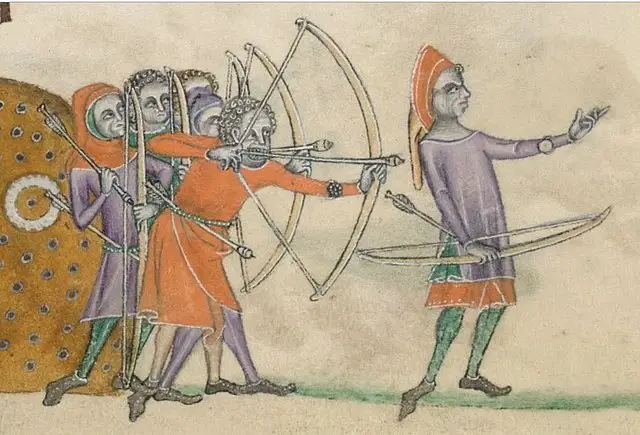
Unlike armies today most medieval soldiers were expected to provide for themselves while out on campaign. This was because each soldier was either a conscripted peasant, noble knight, or part of a mercenary band. Each of these 3 groups of medieval soldiers obtained financial wealth from the army in their own way and were responsible for using that wealth to provide for themselves and their men.
For example, if you were a conscripted peasant who was forced to fight against another medieval army then it was expected that you would show up with your own weapons. This often was simply just your traditional tools that you used for farming, baking, or even smithing. You would scavenge the local area in order to resupply yourself and your fellow soldiers.
If you were instead part of a noble’s fighting force as a knight then you would often provide your own equipment and fighting weapons. Here you would have to provide a horse, armor, and weapons along with enough food to sustain yourself as you and your party marched with the army. Where did you get these things you might ask? Well, they often came from the fief that you had control over. Here you would have the smith make you some armor as well as a weapon and take some of the food from your peasantry.
Finally, if you part of a mercenary company then you would have to buy your own food and equipment. However, your pay was provided by a lord of the army so in essence, this is the only group that was not expected to pay for their own supplies. It was expected that you would use a portion of your salary as a mercenary to buy your own equipment and food.
Simply put, for a vast majority of the average medieval army each soldier was expected to provide for themselves. Most of the medieval army was comprised of conscripted soldiers who were forced to fight as part of their social contract agreement with the lord of their village or town. It was not until the 15th century that the Kingdom of France started to create a professional standing army that provided all of the supplies for the medieval army and its soldiers.
Conclusion
There you have it; everything you ever will need to know about how medieval armies were supplied.
The study of the logistics of medieval warfare is a fascinating subject. Most people are not aware of just how complex a medieval campaign would be. From the gathering of the troops, the formations of battle, and the logistics of keeping the army moving it was a massive organization. Today with the help of computers our modern militaries are capable of streamlining logistics but in the medieval period, a good commander would require a whole garrison of people to help resupply his soldiers.
I hope you enjoyed this article. Here at The History Ace, I strive to publish the best history articles on the internet. Feel free to sign up for the free newsletter and share around the web.
Further, you can check out some of the other articles below.
-
How Medieval Armies Were Supplied

How were medieval armies supplied? Well the logistics of keeping a massive group of soldiers moving was unique to this period.

